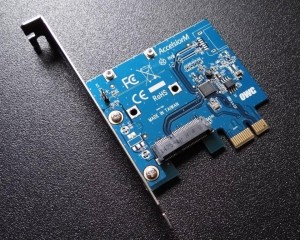 With the popularity of mSATA SSDs being all the rage as of late, it was only a matter of time before a new PCIe adapter was introduced that might allow users to take advantage of that extra storage should they find an mSATA SSD at a great price.
With the popularity of mSATA SSDs being all the rage as of late, it was only a matter of time before a new PCIe adapter was introduced that might allow users to take advantage of that extra storage should they find an mSATA SSD at a great price.
Our review today will look at the new OWC Mercury AccelsiorM mSATA controller and some might be surprised to learn that this device is the industry’s first fully bootable Mac and PC plug and play mSATA controller release.
Specifications list transfer speeds for the Mercury AccelsiorM at 380MB/s read and write performance and detail it as being a low profile PCI Express card using the PCIe 2.0 x1 interface. It is fully bootable and 100% plug and play with no driver installation whatsoever. Compatibility is included for, not only Windows and Mac OS X but also, Ubuntu and Fedora and the Mercury AccelsiorM comes with a 3 year warranty.
OWC’s Product Page lists the AccelsiorM at $33.95 which, even with the price of some present 256GB mSATA SSDs, can still be cheaper than the typical SSD solution. In our analysis, we tested with several different mSATA SSDs including the Micron C400 256GB mSATA SSD seen above and the ADATA XPG SX300 256GB ‘LSI SandForce Driven’ SSD that was used specifically for these performance measurements.
We expect to be posting our review of the ADATA XPG SX300 mSATA SSD sometime this week for reference, however, should you want immediate comparisons to the benchmarks shown here, our review of the MyDigitalSSD SMART 256GB mSATA SSD should suffice as it is the ADATA XPG SX300 with a different sticker on its face.
INSTALLATION
Installation consisted of fastening the mSATA SSD to the AccelsiorM, inserting it into any PCIe slot, and rebooting. On reboot, you gain about two seconds to your start time while the card and its ASMedia 106x Controller is recognized.
From there, the mSATA SSD is recognized just as it would be in any other circumstance and additional storage is at your fingertips. For our testing, we used Paragon Migrate OS To SSD and migrated our OS to the new drive, removing the original SSD and rebooted. The OS was immediately recognized on the new drive and, short of the few seconds lost while the card was initiated, the system booted and ran without a hitch. Our benchmark testing was conducted with the AccelsiorM and mSATA set up as a secondary resource.
BENCHMARK EVALUATION
For our benchmark program, we knew that the AccelsiorM was limited to 380MB/s read and write and wanted to concentrate on such things as it reaching SATA 3 speeds consistently as well as those all important 4k random write speeds. With this in mind, we elected to run our full battery of tests to include ATTO, Crystal DiskMark, AS SSD, Anvil Storage Utilities and PCMark Vantage.
Our initial ATTO results were slightly higher than specifications with highs of 403MB/s read and 389MB/s write. Our testing of the same mSATA card without the AccelsiorM displayed both read and write performance at above 525MB/s. As much as we might like to see full performance, the ASMedia controller restricts that, although SATA 3 performance is still evident.
 The SSD Review The Worlds Dedicated SSD Education and Review Resource |
The SSD Review The Worlds Dedicated SSD Education and Review Resource | 

Can you RAID two of these cards on an ICH10 chipset?
The Accelsior is raidable on a mac pro at least..
very interesting solution but it would be nice to see this with 2 or more msata
+1 Inovation
I would love to see a “Professional” or “Enthusiast” version that utilizes a PCIe x4 or even x8 slot, and has space for 2-4 mSATA SSD’s and uses an actual LSI hardware RAID chip and a nice and round 1024MB of DDR3 cache to RAID0/1/5/10 the drives, and maybe even a small integrated Battery Backup for use during power failures (enough to keep the drives holding data for 48-72hrs shouldn’t be expensive nor take up hardly any room).
Can you imagine a 4x256GB RAID-0 array capable of 2GB/s reads/writes, and the entire thing is smaller than a sound card??? OH WHAT I WOULD GIVE!
BEWARE! Installing the AccelsiorM with a 256GB mSATA card in my Mac Pro has screwed up native boot into the separate Mac Bootcamp partition (Bay2 Drive). The screen gets as far as “Using PCIE Gen 2” but no further.
The card is fine running MACOS (boot time under 12 seconds) but won’t boot via the Option key into Win7 on start up. Anyone got any suggestions?